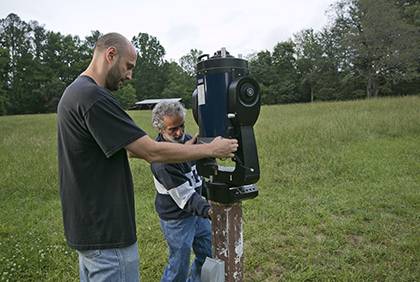Spend an Evening Among Stars and Planets
The Duke Teaching Observatory holds free, open-to-the-public stargazing events

“Oh, a shooting star!” exclaimed Duke associate professor Dan Vermeer.
Huddled together with his wife, Saritha, and their two children, the family stared up at the night sky. It was their first time stargazing in Duke Forest with the Duke Teaching Observatory, which is led by a Duke physics professor and Department of Physics volunteers and features five Meade LX200GPS Schmidt-Cassegrain telescopes.“Anytime you really pay attention to the skies, there’s the vastness, the complexity, the texture that’s not visible to the human eye, but with tools you can begin to realize how beautiful and how intricate those systems really are,” said Vermeer, executive director of the Center for Energy, Development, and the Global Environment at Duke’s Fuqua School of Business.Open-to-the-public stargazing events are scheduled on certain Fridays through the fall and spring semesters at the Duke Teaching Observatory, which is tucked within pine trees off Cornwallis Road in Durham. On a clear night, visitors can see star clusters, Mars and binary stars. Duke’s stargazing tradition started on the roof of the Physics Building in 1997, when physics professor Ronen Plesser discovered an unused, little observatory with telescopes. The first time he climbed the steps to the roof and tried using one of the working telescopes, he found Saturn.He was hooked.“The easiest way to get people excited about science is to show them stars,” Plesser said. “I’m serving the science community by getting a lot of people excited about science. Some of the kids show up and get excited, and down the road, they may become some of my colleagues.”Plesser began to learn about constellations, the nature of stars and planets, by obtaining a key to the roof and teaching the art of stargazing to others. As interest grew across the university, he gained support in establishing the teaching observatory site in Duke Forest. “Over the years, there are people who get hooked and show up every time,” said Plesser, who also teaches astronomy at Duke. “We’ve had people from 9 months old to well over 80.”Yuriy Bomze, a Duke Physics lab manager, helps Plesser with telescope upkeep and with organizing the stargazing open houses. This academic year, Bomze will lead stargazing events while Plesser is on sabbatical. Bomze enjoys spending Friday evenings explaining the stars or helping children take a closer look at the moon. “It’s kind of a small community,” Bomze said. “Everyone is very enthusiastic about it. People keep coming.”
Read More